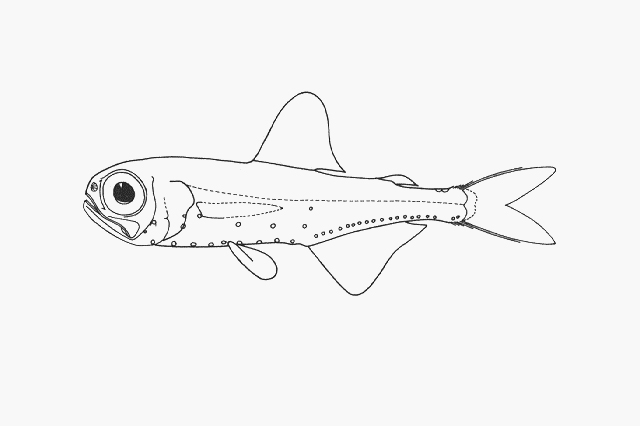Rough Lanternfish, Electrona subaspera (Günther 1864)
Other Names: Bigeye Lantern-fish

illustration of a Rough Lanternfish, Electrona subaspera. Source: South African Institute of Aquatic Biology / FishBase. License: All rights reserved
Summary:
A black lanternfish, with the sides of the head and body silvery.
Cite this page as:
Bray, D.J. 2018, Electrona subaspera in Fishes of Australia, accessed 03 Jul 2025, https://fishesofaustralia.net.au/home/species/3101
Rough Lanternfish, Electrona subaspera (Günther 1864)
More Info
|
Distribution |
Off southern Tasmania and off Warnambool, Victoria; also off Macquarie Island in the Southern Ocean. Elsewhere the species is circumglobal in southern latitudes, except the Indian Ocean. Inhabits mesopelagic and bathypelagic waters during the day, migrating to feed at depths between 0-200 m at night. |
|
Features |
Dorsal fin 13–15; Anal fin 20–22; Pectoral fin 13–16; Pelvic fin 8; Gill rakers 7–9 (usually 8) + 18–22 (usually 19–20) = 25-31. Body depth more than 3 times in SL; AO photophores 15–18 (usually 17); interspace between Prc photophores less than one photophore diameter; SAO1 photophore anterior to vertical through VO3 photophore; PO5 photophore level with upper end of ventral-fin base; mature males typically with 1–3 supracaudal luminous organs; females variable, usually with one or more supracaudal and infracaudal organs, rarely only supra- or infracaudal organs. |
|
Remarks |
The Rough Lanternfish is preyed upon by a wide range of fishes, along with seals and sea birds. |
|
Species Citation |
Scopelus (Dasyscopelus) subasper Günther 1864, Catalogue of the Fishes of the British Museum Vol. 5: 411. Type locality: Indian Ocean, south of Australia (as 'Pacific Ocean'), 43º 30' S, 123º E. |
|
Author |
Bray, D.J. 2018 |
|
Resources |
Rough Lanternfish, Electrona subaspera (Günther 1864)
References
Clark, M.R. 1985. The food and feeding of seven fish species from the Campbell Plateau, New Zealand. New Zealand Journal of Marine and Freshwater Research 19(3): 339-363.
Duhamel, G., Gasco, N. & Davaine, P. 2005. Poissons des îles Kerguelen et Crozet. Publications Scientifiques du Muséum national d'Histoire naturelle (Patrimoines naturelles, No. 63). Paris. : 1-419
Flynn, A.J. & Williams, A. 2012. Lanternfish (Pisces: Myctophidae) biomass distribution and oceanographic–topographic associations at Macquarie Island, Southern Ocean. Marine and Freshwater Research 63: 251–263
Günther, A. 1864. Catalogue of the Fishes of the British Museum. Catalogue of the Physostomi, containing the families Siluridae, Characinidae, Haplochitonidae, Sternoptychidae, Scopelidae, Stomiatidae in the collection of the British Museum. London : British Museum Vol. 5 455 pp. Ref at BHL
Hulley, P.A. 1986. Order Myctophiformes. pp. 282-322 in Smith, M.M. & Heemstra, P.C. (eds). Smith's Sea Fishes. Johannesburg : Macmillan South Africa xx + 1047 pp. 144 pls.
Hulley, P.A. 1990. Family Myctophidae. pp. 146-178 in Gon, O. & Heemstra, P.C. (eds). Fishes of the Southern Ocean. Grahamstown : J.L.B. Smith Institute of Ichthyology 462 pp.
Paxton, J.R. 1979. Nominal genera and species of lanternfishes (family Myctophidae). Los Angeles County Museum of Natural History Contributions in Science 322: 1-28
Paxton, J.R. & Bray, D.J. 2008. Family Myctophidae. pp. 270-294 in Gomon, M.F., Bray, D.J. & Kuiter, R.H. (eds). Fishes of Australia's Southern Coast. Sydney : Reed New Holland 928 pp.
Robertson, D. & Clements, K.D. 2015. 89 Family Myctophidae. pp. 613-680 in Roberts, C.D., Stewart, A.L. & Struthers, C.D. The Fishes of New Zealand. Wellington : Te Papa Press Vol. 3 pp. 577-1152.
Whitley, G.P. 1953. Studies in Ichthyology No. 16. Records of the Australian Museum 23(3): 133-138 figs 1-4 (as Elampadena subaspera)
Young, J.W., Lamb, T.D. & Bradford, R.W. 1996. Distribution and community structure of midwater fishes in relation to the subtropical convergence off eastern Tasmania, Australia. Marine Biology 126(4): 571-584.

